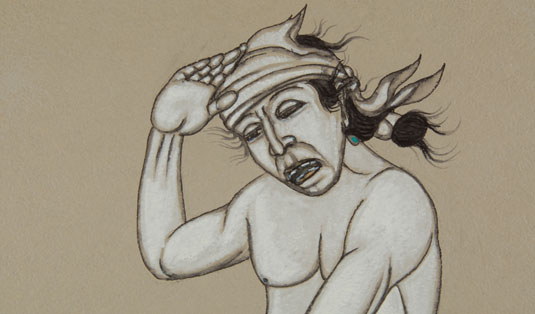Special Value Offer: Original Painting “Fire Dancer” [R]
+ Add to my watchlist Forward to Friend
Forward to Friend
- Category: Paintings
- Origin: Diné of the Navajo Nation
- Medium: casein
- Size: 19” x 14-7/8” image;
26-7/8” x 22-5/8” framed - Item # C3676C
- Price No Longer Available
Special Value Offer: The consignor of this painting has suggested we offer it at a 20% discount from the original price of $950 to a new price of $750.
In the late 1800s, Dr. Washington Matthews observed the Navajo and published information on the tribe, its ceremonies and crafts. In 1909, Oscar H. Lipps published a book entitled The Navajos in which he quoted Dr. Matthews’ description of the Navajo Fire Dance which he called The Fire Play. In 1989, Avanyu Publishing re-published Lipps’ book under the full title A Little History of the Navajos (see reference below).
 In this paining, Beatien Yazz has presented us with one of the fire dancers in active participation of the event. He is dressed only in a loin cloth and his body is covered in gray ash body paint. He dances with a fire stick in one hand.
In this paining, Beatien Yazz has presented us with one of the fire dancers in active participation of the event. He is dressed only in a loin cloth and his body is covered in gray ash body paint. He dances with a fire stick in one hand.
The following description of the ‘Fire Play’ is taken from Dr. Washington Matthews original writing as reproduced by Oscar Lipps:
“The eleventh dance was the fire dance, or fire play, which was the most picturesque and startling of all. Every man except the leader bore a long, thick bundle of shredded cedar bark in each hand and one had two extra bundles on his shoulders for the later use of the leader. The latter carried four small fagots [a bundle of sticks, twigs, or branches bound together and used as a torch] of the same material in his hands. Four times they all danced around the fire, waving their bundles of bark toward it. They halted in the east; the leader advanced towards the central fire, lighted one of his fagots, and trumpeting loudly threw it to the east over the fence of the corral. He performed a similar act at the south, at the west, and at the north; but before the northern brand was thrown he lighted with it the bark bundles of his comrades. As each brand disappeared over the fence some of the spectators blew into their hands and made a motion as if tossing some substance into the departing flame. When the fascicles were all lighted the whole band began a wild race around the fire. At first they kept close together and spat upon one another some substance of supposed medicinal virtue. Soon they scattered and ran apparently without concert, the rapid racing causing the brands to throw out long brilliant streamers of flames over the hands and arms of the dancers. Then they proceeded to apply the brands to their own nude bodies and to the bodies of their comrades in front of them, no man ever once turning around; at times the dancer struck his victim vigorous blows with his flaming wand; again he seized the flame as if it were a sponge, and, keeping close to the one pursued, rubbed the back of the latter for several moments, as if he were bathing him. In the meantime the sufferer would perhaps catch up with some one [sic] in front of him and in turn bathe him in flame. At times when a dancer found no one in front of him he proceeded to sponge his own back, and might keep this up while making two or three circuits around the fire or until he caught up with some one [sic] else. At each application of the blaze the loud trumpeting was heard, and it often seemed as if a great flock of cranes was winging its way over head southward through the darkness. If a brand became extinguished it was lighted again in the central fire; but when it was so far consumed as to be no longer held conveniently in the hand, the dancer dropped it and rushed, trumpeting, out of the corral. Thus, one by one, they all departed. When they were gone many of the spectators came forward, picked up some of the fallen fragments of cedar bark, lighted them and bathed their hands in the flames as a charm against the evil effects of fire.”
From the book: A Little History of the Navajos
Condition: appears to be in original condition. It was recently framed using proper materials. The title “Fire Dancer” and the date “1956” are written on the back of the painting.
Recommended Reading: A Little History of The Navajos by Oscar H. Lipps, Cedar Rapids, Iowa, 1909. This book is currently not available from Adobe Gallery
Provenance: from a gentleman in Albuquerque

- Category: Paintings
- Origin: Diné of the Navajo Nation
- Medium: casein
- Size: 19” x 14-7/8” image;
26-7/8” x 22-5/8” framed - Item # C3676C
- Price No Longer Available



